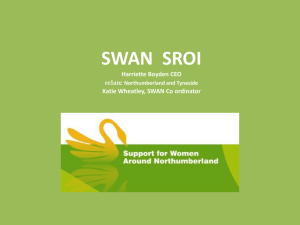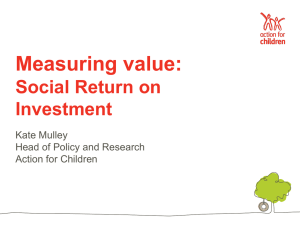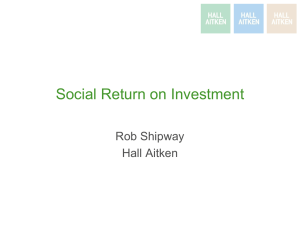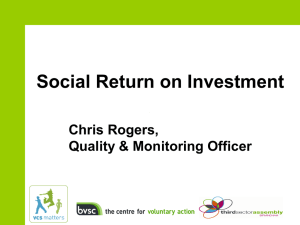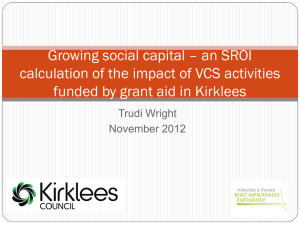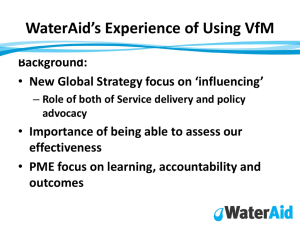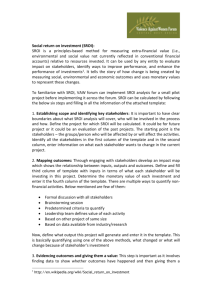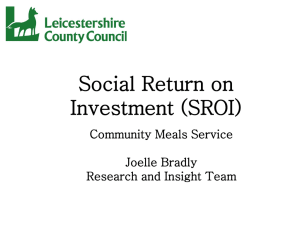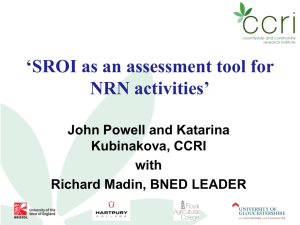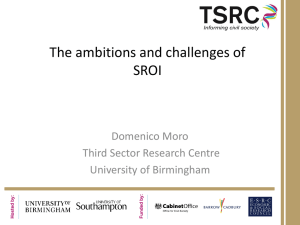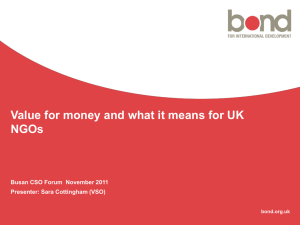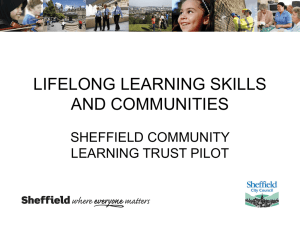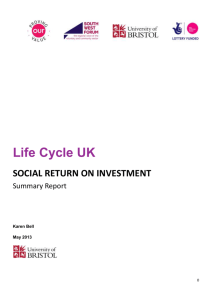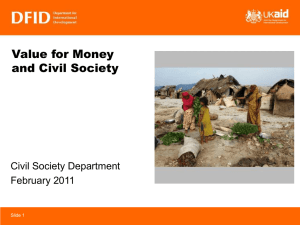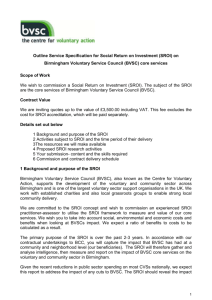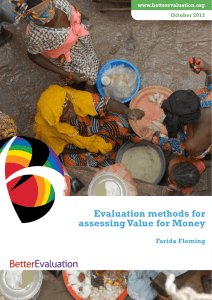ActionAid Value for Money Pilot Update
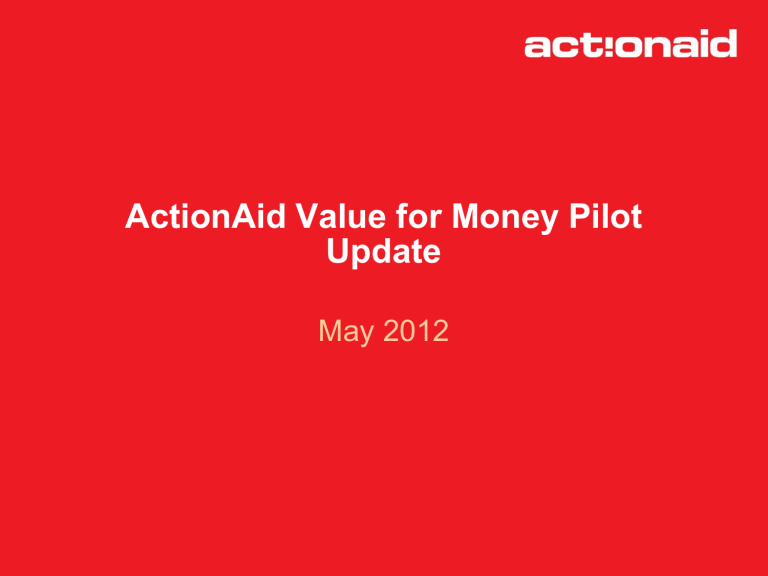
ActionAid Value for Money Pilot
Update
May 2012
Origins of the VFM Pilot
- Measuring cost effectiveness approved in
September 2010 as part of the new Global M&E
System Requirements. Will become core component of monitoring of all ActionAid programmes from 2013.
- Original Aim of Pilot - define cost effectiveness in the ActionAid context as well as test appropriate methodologies and create recommendations for wider implementation.
In the Beginning…
Cost effectiveness defined as an analysis of the relationship between effectiveness and costs (or inputs)
As a charitably funded organisation we know and can show that we are achieving maximum results for reasonable cost
Being able to demonstrate cost effectiveness in a way that upholds our mission and values should enable us to build a case that we represent value for money
Ripping Up and Starting Over
BOND VFM Group helped us debate:
- What about Value for Money? Who decides
Value?
- What about cost efficiency?
- How do we understand and apply within our accountability system (ALPS)?
Cost Effectiveness Pilot becomes the Value for Money Pilot
Agreed Definitions
Cost efficiency: Maximising the output with a given level of inputs (this could include financial and economic costs, such as volunteer time).
Cost effectiveness: Ensuring that you achieve your intended objective/outcome with optimal use of resources. Need to specify outcomes and link
M&E framework to financial and economic costs.
Agreed Definitions
Value for Money (VFM):
- Umbrella term, looks at how to manage costs, improve efficiency, and how to demonstrate that what we are doing is the right thing to do
‘Value’ viewed in terms of what stakeholders, most notably rightsholders, value in terms of what we have promised to deliver – thereby ensuring accountability towards rightsholders as well as donors/public
- VFM is about building and presenting a case
Value for Money in Programme flow
Managing CE Improving CE Demonstrating CE
Appraisal
&
Strategic
Planning
Inputs & resources
(costs)
Activities
& outputs
Outcomes Impact
Appraisal, programme development, baseline
Implementation
Implementation
& monitoring
Review/Evaluation
Application – Cost Efficiency
Application – Cost Effectiveness
Plan for Integration
Include Key Questions in:
• HRBA 2.0 – Programme Framework Guidance
• Global Monitoring Framework
• Revised ALPS
• Evaluation TORs
Ensure Key Questions are addressed – compliance
Build capacity and cross-check systems
What about Assessing Value for Money?
Assessment methodologies and processes:
- Need to build on existing organisational participatory approaches
- Evidence-based, rigorous
- Aligned with mission and values
Help to prove ‘Theory of Change’
- Not just assessing traditional programmes
But how? And with whom?
Partnership with the New Economics
Foundation
- Agree a common understanding and definition of Value for Money as it applies to ActionAid
- Understand and be able to test methods for measuring cost effectiveness and cost efficiency, using tools adapted for ActionAid
- Understand how to create a narrative using the results that would build the VFM case
- Understand how to engage stakeholders in the assessment process – thus giving us the ultimate VFM
Tools for Assessment
Social Return on Investment (SROI) : Cost effectiveness methodology that contrasts outcomes with full economic costs, incorporating externalities for all material stakeholders and using participatory approaches
Adapted SROI : analysing economic costs against outcomes. Not creating ratio but creating a narrative. Include existing data
Cost Efficiency Analysis (CEA) : Measurement of outputs relative to costs
Cost Effectiveness Analysis : Measurement of single outcome relative to costs
Adapted Cost Effectiveness Analysis : Measurement of outcomes relative to costs. Creating a narrative.
Multi-criteria Analysis (MCA) : A (participatory) decision making approach designed to quantify and assign weighting to competing values and criteria of different stakeholders when considering different courses of action
Adapted SROI Template
Adapted SROI
– analysing full costs against benefits. Not creating ratio but creating a narrative.
COST BREAKDOWN
- Financial costs
- Economic costs
ELABORATION OF BENEFITS (IMPACTS)
- Key outcomes
- Tangible
- Intangible
- An estimation of outcome incidence
- Deadweight
- Attribution
- Displacement
- External/indirect impacts
- Benefit period
Pilot Testing Through December 2012
Country
Australia
Australia/UK
UK
Denmark
International secretariat
Nigeria
Ethiopia
Afghanistan
Pakistan
AAI Finance, Regional office,
Thailand
VfM methodology
MCA light
MCA plus
Work stream
Policy scenarios in strategy
SROI
Productive resources
(Agri+land) (via
Kenya/Uganda)
Cost effectiveness light or cost efficiency
SROI
SROI light
Costs
SROI light
Template report (VFM programme cycle)
SROI light
Campaigns (tax justice)
Schools, education, youth
Undetermined (within strategy and existing M&E framework)
General
M&E framework
Across the board
SROI
SROI
Cost-effectiveness light or cost efficiency
LRP (empowerment)
? (project with quality quantitative data)
Women’s rights/advocacy
Existing emergency evaluation
Estimating economic costs Finance - general
